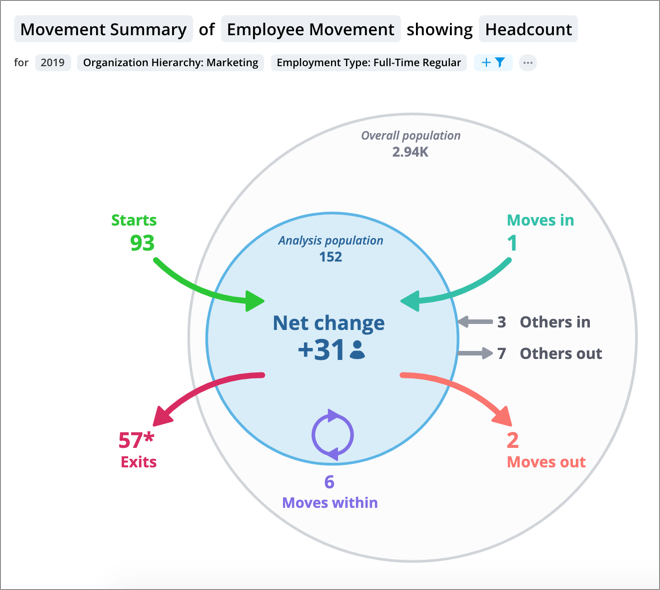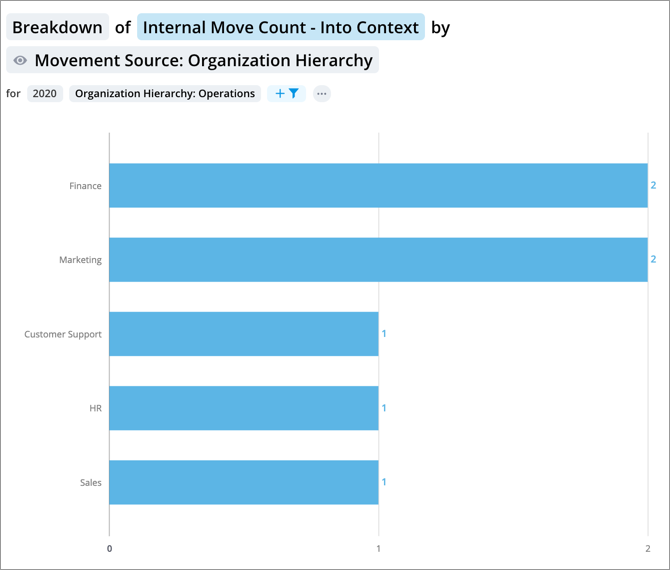Movement Summary Visual
Identify the subject members who are moving in and out of an analysis population.
The Movement Summary visual shows how a specific group or population has changed over the selected period. The inner circle on the visual represents the analysis population. The visual highlights the movements of subject members, such as employees and requisitions, into, out of, and within the group.

Depending on the data that has been loaded and configuration, you can use the visual to analyze different types of movement. The configuration and definition of the types of movement being tracked can be adjusted by your administrator.
Change the visual title to analyze:
- Employee Movement in terms of Budgeted Direct Compensation, FTE, or Headcount.
- Requisition Movement in terms of Open Positions Count or Open Requisitions Count.
Note:
- Discrepancies are not counted in the Movement Summary visual. If you want to identify any discrepancies, use the Movement Breakdown visual. For more information, see Movement Breakdown Visual.
- To change the labels displayed in movement visualizations, see Create a Movement Concept.
Movement overview
The following section uses the Employee Movement model to explain how the visual works. By default, the Employee Movement model is configured to analyze movement based on Organization and Location (primary attributes). For more information, see Employee Movement Model.
Note: The Requisition Movement model is configured to analyze movement based on Requisition Status.
For Employee Movement, the visual highlights:
- Starts: Employees that joined the group from outside of the organization.
- Exits: Employees that left the group by leaving the organization.
- Internal movement: Impacts to the group from existing employees due to changes in the primary attributes. By default, this shows employees who have changed organizational units or locations. Movement for Moves in and Moves out will only appear if you have applied a filter based on a primary attribute to the visual.
- Moves in: Existing employees who joined the group, as a result of changing their organizational unit and/or location.
- Moves out: Existing employees who left the group, as a result of changing their organizational unit and/or location.
- Moves within: Existing employees who changed their organizational unit and/or location, but still remain part of the group.
- Other movement: This movement type will only appear if you have applied a filter based on a secondary attribute to the visual. For Employee Movement a secondary attribute is any filter that is not based on Organization or Location. This summarizes employees who had changes relevant to the filter that stayed in the group throughout the period:
- Others in: Existing employees who joined the group, as a result of a change related to the filter.
- Others out: Existing employees who left the group, as a result of a change related to the filter.
How to interpret the movement metrics
Let's say, you're analyzing Employee Movement for the Marketing unit and you've applied a filter defined as Organization Hierarchy: Marketing. Here's how you should interpret the movement:
- Starts: New employees who joined the organization in Marketing.
- Exits: Employees who left the organization in Marketing.
- Moves in: Existing employees who joined the group by changing organizational units or locations. For example, an employee moves from Sales to Marketing.
- Moves out: Existing employees who left the group by changing organizational units or locations. For example, an employee moves from Marketing to Finance.
- Moves within: Existing employees who are still part of the group who changed their organizational unit and/or location. For example:
- An employee moves from the Marketing unit in New York to the Marketing unit in Los Angeles.
- An employee moves from the Product Marketing unit to the Demand Generation unit.
- As part of a reorganization, an employee reports to the Content Marketing Manager instead of the Vice President of Marketing.
Let's say, you're interested in the movement of full-time employees, so you apply another filter using a secondary attribute defined as Employment Type: Full-Time Regular. Here's how you should interpret the movement:
- Others in: Existing employees who joined the group, as a result of a change related to the filter. For example, an employee in Marketing who becomes a full-time employee.
- Others out: Existing employees who left the group, as a result of a change related to the filter. For example, an employee in Marketing who transitions to part-time.
How to explore the visual to gain insight
- Set the analysis population by applying filters to isolate the population of interest.
- Change the time period of analysis to identify any sudden increases or decreases in movement.
- View a summary of the movement and changes in the Info panel by selecting a movement metric. For Employee Movement, look at the count of movement due to changes in organizational units or location.
- View a list of subject members who are moving in and moving out of the analysis population by clicking View details in the Info panel.
See where specific subject members moved in from or moved out to. Select Moves in or Moves out and then click View Details to answer questions like: Which location did this employee come from? In Detailed View look for the attributes that are included in your analysis context to see the subject member's source and destination. For example, California > New York indicates an employee moved from California to New York.

- Visualize the movement of subject members by their source or destination to answer questions such as: Where did the employees who moved out of my analysis population go? To do this, select a movement metric and then click Explore sources or Explore destinations under Try Next in the Insights tab of the Info panel.
- Select from the following movement metrics when analyzing Employee Movement. By default, internal movement looks at changes to primary attributes (applied filters that are based on organization unit or location) and other movement looks at changes to secondary attributes (applied filters that are not based on organization unit or location such as employment type).
- Net change: Explore sources and destinations of moves in and moves outs.
- Moves in: Explore sources and destinations for moves in based on changes to primary attributes.
- Moves out: Explore sources and destinations for moves out based on changes to the primary attributes.
- Moves within: Explore sources and destinations for moves within based on changes to primary attributes.
- Others in: Explore sources and destinations for other moves in based on changes to secondary attributes.
- Others Out: Explore sources and destinations for other moves out based on changes to secondary attributes.
- For example, let's say you are analyzing Employee Movement for the Operations unit and you see that 7 employees have moved into Operations. You want to know where these 7 employees came from to get an idea of the skills they'll be bringing to your unit. To answer this question, click Moves in and then click Moves in: explore sources in the Info panel. This will take you to a Breakdown visual that shows the employees who moved into your analysis population grouped by their source. In this example, you'll see a summary of the employees and the organizational units they came from.

- Change the group by in the breakdown to see the sources and destinations for different attributes (other filters that you've applied). Look under the Movement category in the Group By picker for a list of available attributes.
- Select from the following movement metrics when analyzing Employee Movement. By default, internal movement looks at changes to primary attributes (applied filters that are based on organization unit or location) and other movement looks at changes to secondary attributes (applied filters that are not based on organization unit or location such as employment type).
Tip:
-
Right-click on a chart item or data point to open the Visual Item Actions menu. Find actions that will allow you to quickly interact with points of interest. Actions include drilling up or down to view different levels of your data and accessing the Detailed View visual to see a list of subject members or event occurrences that make up a given population.
- You can also visualize the movement of subject members by their source or destination without selecting a data point. To do this, click Moves in: explore sources or Moves out: explore destinations under Try Next in the Insights tab of the Info panel.
